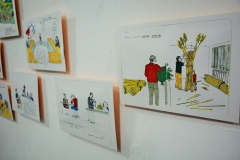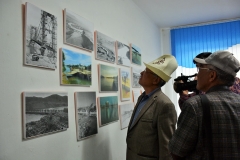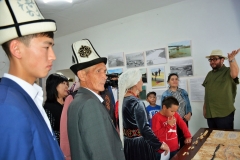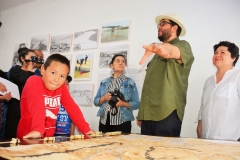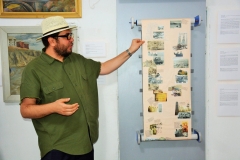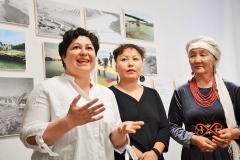Beginnings 2019

In June 2019, we invited ten artists and designers to develop a river
exhibition with our research team at the Historical-Ethnographic Museum
of Naryn Province in Kyrgyzstan. Led by Mohira Suyarkulova and
curatorial advisor Georgy Mamedov, our collective remit was to dramatize
human, non-human and alternative river stories. Participants with a wide
range of skills such as exhibition design, drama and illustration
responded to our call. The University of Central Asia hosted us for ten
days at its new Naryn campus, allowing us to explore the Naryn river and
meet the people of its valley. We accompanied the exhibition opening
with public lectures and the launch of the children’s illustrated book
Tanais and Tal. A video version of this tale is available here in Kyrgyz, Kazakh and Russian.
Before the Covid pandemic hit, we had planned taking
this exhibition on tour downriver, to highlight connections and enable
meetings between riparian residents in all the four countries that this
river touches. Even in the most challenging situation, we are convinced
that finding ways of living more fairly and healthily with Central Asian
rivers is possible and worthwhile. An expanded virtual exhibition,
translated into all the major languages spoken along this river, is our
answer to current limitations.

“Confluence” is the story of the project inspired by the discoveries made by the scholars of the ‘social life’ of the Naryn-Syr Darya river. In collaboration with artists, they decided to gather in Naryn aiming to share their findings as an exhibition.

A bridge is a piece of magic. They make things possible that were not possible before. Thinking a bridge assumes that there is something you want to step over, across, not have contact with. They are always placed, and can also be removed, very deliberately. Bridges are like arrows that point in two directions at the same time. Every bridge has its own story.

It is the year 2548. Archaeology professor Zulya Esentaeva, Dr. Jeanne Féaux de la Croix, Dr. Aidai Maksatbekova, Dr. Deniz Nazarova and Dr. Dinara Kanybek Kyzy have made a sensational find from the plastic century in ancient Naryn. According to the researchers’ analysis, the find dates to 2350 AD. and consists of a dinner plate with the remains of plastic food. The untouched food was left behind suddenly in the home for unknown reasons.

“In the flow” is a cyclic structure, illustrating the various flows circulating between Shamaldy-Sai and Moscow. These two distant places were once linked by ambitious projects of modernization.

Traditional water managers in Central Asia used to be called “Mirabs.” The profession of “mirab” has disappeared in its traditional understanding from the Central Asian region. The closest parallel today are municipal workers who perform the duties of “mirabs” these days.

Historically in/ability to swim reflected the existing structures of inequality – women often do not have access to the same resources and skills as men, including the resources and skills linked to the rivers and other bodies of water. At times, this denial of access to the river and inability to swim may cost women lives.

Baiterek is an emblematic building of modern Qazaqstan. By making Baiterek out of reed, we wanted to make a claim that common reed holds a great potential for becoming a building material of the future.

Photography by Toma Peiu, Luiza Pârvu
River Flows is a photographic series capturing everyday landscapes from the Aral Sea basin.

This book tells the story of the water being Tanais and her love for Tal, a willow tree that grows on the river bank. One day Tanais wakes up and cannot find her beloved Tal in her usual place.

